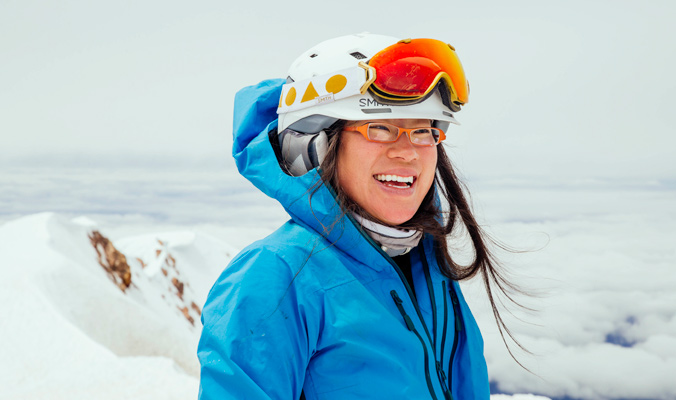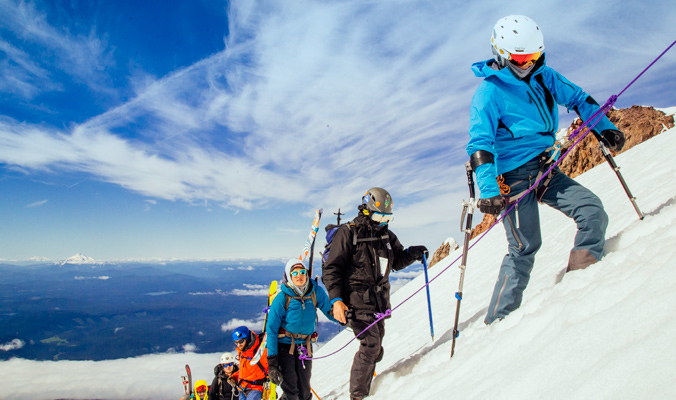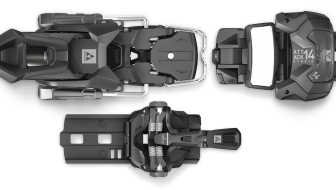Anna Soens didn’t expect that she’d become an adaptive role model over the last two and a half years. In December 2015, however, the 30-year-old Boise, Idaho-based wildlife biologist fell 35 feet at a climbing gym, breaking her lowest thoracic vertebra, an injury that left her with partial paralysis from the hips down. As an avid climber, she was unwilling to let the accident keep her from the outdoors, so she began contacting area adaptive sports centers. Oregon Adaptive Sports in Bend became her new avenue to athletic pursuits, which culminated last May with Soens’s summit and sit-ski descent of Mt. Hood. To support this and future trips, she created the Climb On Project, an initiative dedicated to encouraging athletes of all abilities to pursue big-mountain dreams and normalize adaptive athletic achievements.

Anna Soens takes a moment on the summit of Mt. Hood to celebrate her two-day ascent. [Photo] Lauren Danilek
Mt. Hood was a personal project that my dad and I had sights on to climb together before I broke my back. My parents live in Portland, and you can see Mt. Hood from the city. It’s super iconic. When I fell, thoughts of climbing Mt. Hood got put on hold for a while but never completely died. Then, around a year after I fell, I started thinking about it again. I was like, “Well, it’s not completely impossible. It will probably suck a little and will definitely be a sufferfest, but I’m gonna contact a bunch of friends and see if people are interested in helping out.”
In a lot of ways Mt. Hood was symbolic of my recovery in general and helped prove that my spinal-cord injury wasn’t going to force me to change the course of my life or stop me from doing the things that were important to me.
One of the biggest barriers to getting back outdoors was the equipment. I don’t have the luxury of simply grabbing a pair of hiking shoes and a bottle of water and losing myself in the wilderness on my own anymore. My hiking shoes now come in the form of a three-wheeled, hand-cranked adaptive mountain bike, which is $9,000. But without it, there’s no way for me to get onto dirt trails. My sit-ski—without the actual ski or bindings—is $10,000. I wouldn’t have been able to afford any of this without the help of grants from organizations that help people with traumatic injuries and physical disabilities.

Soens and her team adapt to the climb on Mt. Hood, Ore. [Photo] Lauren Danilek
I don’t think people realize just how cost-prohibitive a lot of this equipment is. It’s a huge financial and mental barrier for a lot of people and one of the reasons why the adaptive sports community and nonprofits like Oregon Adaptive Sports have been critical for me and for other people I know.
Without having the strong community of other adaptive athletes and organizations helping out, getting back outdoors and active can feel impossible because you feel like you’re constantly reinventing the wheel. Accessing the backcountry is not a straightforward objective for able-bodied folks, and for those with disabilities, the challenges are compounded in a thousand different ways. But organizations like Oregon Adaptive Sports have the equipment and know-how and helped introduce me to sports new and old.
The Climb On Project was meant to build on that and contribute to the strong, close-knit adaptive sports community by highlighting bigger pursuits by disabled athletes and raising the bar of what people with disabilities and without think is possible. The coolest things I’ve done in my life have always come when I’ve tentatively decided to chase a harebrained idea that I’d been on the verge of dismissing. I hope that the Climb On Project helps nudge others who are teetering on that precipice.
People see me as different, but I think most of Backcountry’s readers can relate to the fact that getting into the backcountry is something that’s really important to them, whether it’s through skiing, climbing, hiking or camping, and that’s no different for me now. These adaptive sports organizations and nonprofits are not just organizing field trips and outings to help people get outside—they’re facilitating a fundamental lifestyle of freedom, exploration and boundary-pushing. They’re not helping a community that’s existing in this abstract sphere that’s completely different than your own. They’re helping people just like you; they may just get around on wheel rather than by foot.
Oregon Adaptive Sports
The state’s primary adaptive outdoor-recreation organization, Oregon Adaptive Sports provides equipment and instruction to help those with disabilities get out year-round. oregonadaptivesports.org
Climb On Project
A coalition of friends and family rallied together to create the Climb On Project after Soens’s accident. The fundraiser (still ongoing via Oregon Adaptive’s website) has tallied nearly $10,000 and made it possible for Soens to achieve her Mt. Hood goal.










Anna rocks! Thanks for sharing her story.